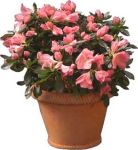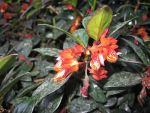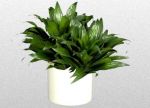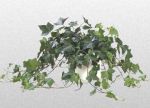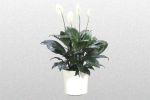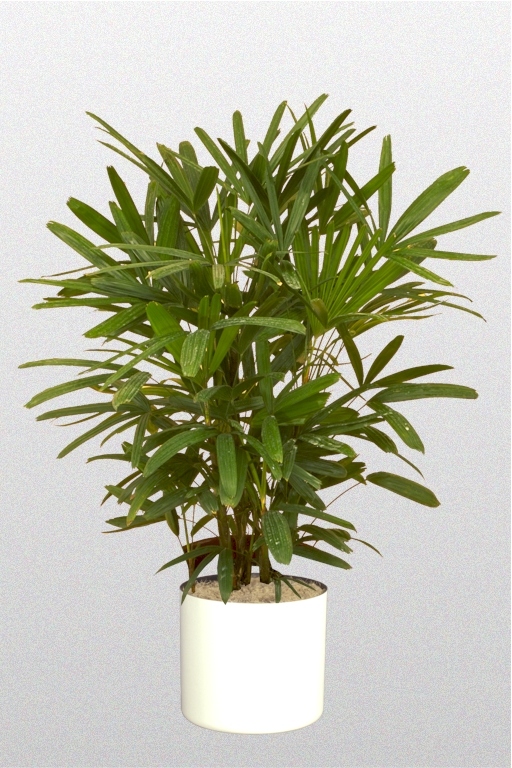Some plants need to dry out, some need to be moist, none need to be soggy. Plants with thin leaves ususally require more water than plants with thick leaves since plump leaves store water longer than flat leaves. A sansiviera or Mother in Law’s Tongue with long thick leaves needs to be watered less frequently than a spathyphylum or peace lily with large thin leaves. These two plants could never be on the same watering schedule.
Succulents such as Pepperomia, Hoya, Jade, Crown of Thorns and Cactus like their soil to thoroughly dry out. Plants that flower or those that are constantly getting new leaves (Ficus, Azalea, Coleus, Wandering Jew) need more water.
The same plant, in the same pot, will have different watering needs depending upon where it is located. A plant in a warm, bright location uses more water than the exact plant in a dark cool location. If a room is dry, a plant needs more water than if the room is humid. Even though plants may be identical, their location influences how often they need water.
Plants in small pots dry out faster than plants in large pots. Always leave your plant in its grower’s pot and never plant it directly into a decorative pot. This prevents over watering caused by repotting a plant into a much larger container where the soil never has a chance to dry out and eventually leads the roots to develop root rot.
Porous containers allow a plant to dry out much faster than nonporous containers since water can evaporate through the sides and bottom of the pot. Consequently, if a plant is in a terra cotta or clay pot it will dry out faster than if the same plant is in a plastic or ceramic container.
Certain types of soil dry out faster than others. If your soil is heavy and claylike with some peat moss, it will retain water longer than a soil that is very sandy or has some perlite in it. We personally like Miracle Gro soil. It seems to have a perfect balance.
The time of the year influences how we care for our plants in many ways. Plants will grow faster in the spring and summer than in the fall and the winter. The faster a plant grows the more water and fertilizer it requires. When a plant is not actively growing, cut back or totally eliminate fertilizer so that it does not accumulate in the soil and burn the roots. The same with water; it will take longer for the soil to dry out when the temperatures are colder, so you will not have to water the plants as often.
There are other factors we tend to forget that may cause care problems. When it is raining a great deal or the humidity is high, water less often. When the heat kicks on in the winter and a room suddenly becomes hotter and dryer, water more often. When the air conditioner is turned on in the summer and the room cools down quite a bit, water less often.
The light coming in your windows will vary depending upon the time of year. A plant may be sitting on a table and getting great sunlight in the summer, but in the winter getting very little light; or the light may be perfect in the winter, but too intense in the summer. Try moving your plants to different locations during the year if they require specific light conditions.
Plants that have been grown outside before coming to your home may be affected by season changes. A ficus tree that has been doing beautifully may suddenly start dropping leaves in the fall. The plant is basically healthy but its internal clock tells it that the seasons are changing and its time to drop some leaves.
When you bring a new plant home, it will need quite a bit more water than it would usually require once it becomes acclimated to it’s new surroundings (consider it like intensive care for a few weeks). This doesn’t mean you should drown it. Just be on the lookout for signs that it may be dehydrated; i.e. oldest leaves drop off, plant wilts, flower buds fall off, no new leaves appear or if they do, they are very small.
1. If possible lift the plant. If the plant is heavy, it doesn’t need water.
2. Look at the soil; as it dries out it will turn from a dark brown to a lighter pale brown.
3. Get your fingers dirty. Stick your finger into the soil; for a 6” pot at least the top 1” of the soil should be dry, for an 8” or 10” pot the top 2” should be dry. Moisture meters are easily influenced by the salt content of the soil, therefore may give a false reading. Fertilizers contain soluble salts. So a well-fertilized plant may register as wet even though it is dry. Use a water meter, especially for large plants that you can’t lift, like a toothpick when baking a cake. Stick it into the soil several inches, if it comes up with moist soil clinging to the tip; you know the plant doesn’t need water. 4. Over watering: Take a minute to look at the plant, in many cases the plant will tell you what the problem is. If the leaves are wilted and the soil feels wet, you have over watered the plant. The roots are dead or dying from lack of oxygen, and water & fertilizer are not being absorbed. Cut off the dead growth. Try taking the plant out of its container. Sometimes if the soil is exposed directly to the air, it will dry out enough & the plant can be saved. Other signs of over watering include: flower buds fall off without opening, new leaves are small, turn black & fall off (ficus), green leaves fall off (schefflerra), all of the old leaves fall off (croton), fungus (toadstools) grow in the soil. The worst is when there is an awful methane sulfur smell, something like rotten eggs. Here are a few signs of over watering that are often mistaken for under watering: Ferns & wandering jews get brown & crispy in the middle. Grape & oak leaf ivies get brown crunchy leaves. The tips of the leaves on dracaenas & palms turn brown. Remember, when in doubt, don’t water. It’s easier to save an under watered plant than an over watered plant.
5. Under watering: Under watering will not kill a plant as quickly as over watering; but after a period of time, the results are the same. If a plant is consistently under watered the roots become damaged in two ways: dehydration and being burned by the salts in fertilizers. Remember, you must look at the plant and test the soil for moisture because, in some cases, problems that indicate under watering mimic those that indicate over watering. In under watering, leaves wilt, becoming soft & droopy, when the soil is dry. An entire branch may petrify and turn brown (Norfolk Island Star Pine). Fronds turn a yellow or even orange color (palms). Some plants turn very pale, losing their vibrant green color (ferns, spider, China Doll). In severe cases of under watering, the soil will pull away from the sides of the pot. When this happens, water simply runs through without hydrating the soil. There are a couple of solutions for this problem. If the pot is small enough, submerge it in a bucket of water (up to the pot brim); you will see bubbles floating up. This is the oxygen escaping as water is taking its place in the soil. When this problem happens with large pots, add a couple of drops of liquid dish detergent (Ivory) to a few gallons of water; then water the plant slowly until the water comes out the bottom drip holes. A few other indications of under watering include: the tips or margins of the leaves turn brown, leaves and flower buds drop off or just don’t develop. 6. Always water a dry plant with plain water before using water with fertilizer in it. This will prevent the salts in the fertilizer from burning the roots of the plant.
7. When you water, water thoroughly, until you see the water come out of the drip holes at the bottom of the pot. This leaches out any salts and chlorides that have been building up in the soil from the use of fertilizers. The plant should be sitting in a drip saucer, which will catch this excess water. You should go back and empty the water out of the drip saucers; if you don’t the plant merely reabsorbs the salty water you have just rinsed out.
8. Water treated by a water softening system should never be used with plants. This puts too much salt into the soil and damages the roots.
9. The ideal temperature of the water you use should be between 62 and 72 degrees. If the water is too cold the roots can’t absorb it. It’s best to water your plants early in the day so that the leaves and soil dry out a little before the nighttime chill. 10. Changes can affect your watering schedule. Be careful not to over water when:
the air conditioning starts in the summer,
there are several days of dark cloudy weather
, the plant is resting after a burst of new growth or flowers
. 11. Mulch, gravel, and moss help the soil retain moisture
The first thing to keep in mind, as always, is that plants will do better if they get too dry than if they are kept too wet. If you are going away for ten days and you usually water your plants weekly, just manipulate your watering schedule so you water them on the day that you leave. Give the plants a little extra water, and then forget about them until you return. When you get back the plants may be quite dry & even be drooping a little. Although this isn’t good on a regular basis, once in a while it won’t do much harm. When you water after a vacation & the plants are extremely dry, never use fertilizer. This will burn the dry roots. Now would be a great time to use an excellent product called SUPER THRIVE. This is a plant stimulant not a fertilizer; and can be used in conjunction with a fertilizer when you are feeding your plants. Super Thrive works best with dry soil. We recommend it for plants that have been stressed, new plants that are getting acclimated, and sick plants that don’t seem to be growing well. Two-ten drops per gallon of water are all that you need.
|
Azalea |
||||
